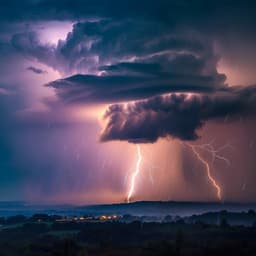
Earth Sciences
Southern Himalayas rainfall as a key driver of interannual variation of pre-monsoon aerosols over the Tibetan Plateau
W. Liu, C. Zhao, et al.
Explore how pre-monsoon aerosol levels on the Tibetan Plateau are influenced more by rainfall in the Southern Himalayas than by winds. Research from Weichen Liu, Chun Zhao, Mingyue Xu, Jiawang Feng, Qiuyan Du, Jun Gu, L. Ruby Leung, and William K. M. Lau sheds light on the complex interactions between aerosols, fire events, and climate dynamics.
~3 min • Beginner • English
Introduction
The study investigates why aerosols over the Tibetan Plateau (TP) during the pre-monsoon season exhibit strong interannual variability. The TP, adjacent to major aerosol source regions such as the Indo-Gangetic Plain and Thar Desert, receives significant contributions from biomass burning, dust, and anthropogenic emissions. Prior work emphasized wind-driven transport, suggesting stronger winds enhance aerosol loading on the TP. The authors hypothesize instead that rainfall over the southern Himalayas is the dominant driver of interannual variability by both suppressing fires (biomass burning emissions) and increasing wet scavenging, whereas the commonly observed positive correlation between wind speed and TP aerosols arises from co-variability with precipitation rather than direct transport effects.
Literature Review
Previous studies documented pre-monsoon transport of biomass burning and dust across the Himalayas to the TP and highlighted roles of valley/glacier winds and westerlies in aerosol transport. Statistical analyses linked enhanced winds to higher TP aerosol, and large-scale factors (e.g., Arctic sea-ice loss) to intensified subtropical westerlies and increased transport. However, meteorology can also modulate sources: fires respond to wind and precipitation, and precipitation removes aerosols via wet deposition. Existing work primarily used correlations without disentangling the coupled effects of wind and rainfall on both sources and transport. The current study addresses this gap by jointly analyzing fire activity, precipitation, winds, and aerosols, and by using targeted model experiments to infer mechanisms.
Methodology
Observational and reanalysis analyses (2003 onward) and numerical modeling were used. Datasets: MODIS active fire (fire density), MERRA2 (AOD and 10 m wind), APHRODITE precipitation (0.05°; 1998–2015), with corroboration from other precipitation datasets. Two TP sites were emphasized: QOMS (southern edge) and Nam Co (interior). AOD from MERRA2 was used due to discontinuities in AERONET records, with validation against available AERONET data. Interannual correlations among AOD, fire density, wind speed, and precipitation were computed for March–May. Partial correlations were used to control for confounding between wind and precipitation. Convergent cross-mapping was applied to probe potential nonlinear causal relationships between South Asian meteorology and TP AOD.
A simple linear regression model predicted interannual fire density using regional rainfall and near-surface temperature as predictors: Fire(year) = −0.67 × rain(year) + 10.81 × temp(year) − 3084.33 (units per Methods). Model performance: correlation with MODIS 0.67, R² = 0.45; precipitation alone explained 56% of variance in predicted fires.
Numerical experiments employed the USTC WRF-Chem v4.0 with quasi-global domain (145 × 360, 1° × 1°) and 40 vertical levels to 50 hPa. Simulations ran from 25 March to 2 May each year with a 6-day spin-up; April output analyzed. Lateral boundaries in meridional direction and initial meteorology from ERA-Interim (80 km, 6-hourly). Above-PBL nudging of winds and temperature to reanalysis (nudging coefficient 3×10⁻⁴ s⁻¹; 6 h timescale). Chemistry used CBM-Z with an 8-bin aerosol module. Physics: Morrison two-moment microphysics, Community Land Model, Mellor–Yamada–Nakanishi–Niino PBL, RRTMG radiation. Emissions: FINN biomass burning (hourly), EDGAR HTAP v2 anthropogenic. The model version includes diagnostics of contributions of processes (transport, wet/dry deposition, PBL mixing, chemistry) to column concentrations.
Key experiments: Ctrl-2015 (2015 meteorology and 2015 emissions), Ctrl-2016 (2016 meteorology and 2016 emissions), and Exp-2015 (2015 meteorology with 2016 biomass burning emissions) to separate emission versus meteorology impacts. Additional paired-year sensitivity experiments contrasted meteorological conditions (2011 vs 2012; 2017 vs 2018) while holding biomass burning emissions identical to the higher-fire year. Differences in AOD and process budgets were analyzed to assess the relative roles of transport and wet removal under contrasting wind/precipitation regimes.
Key Findings
- AOD over QOMS and Nam Co during pre-monsoon exhibits significant interannual variability (e.g., QOMS 0.08–0.14; Nam Co 0.08–0.12).
- Fire density over the southern Himalayas correlates strongly with TP AOD: r = 0.85 (QOMS, 99% confidence) and r = 0.47 (Nam Co, 95% confidence).
- Near-surface total wind speed correlations with AOD are much weaker: r = 0.48 (QOMS) and r = 0.12 (Nam Co).
- Pre-monsoon precipitation over the southern Himalayas is highly anti-correlated with fire activity (r = −0.75). Years with lower AOD coincide with higher rainfall and reduced fires.
- Partial correlations controlling for confounding: precipitation vs AOD at QOMS r = −0.76 (p = 0.003), whereas wind vs AOD controlling for precipitation r = 0.45 (p = 0.083).
- Convergent cross-mapping indicates significant links between precipitation over South Asia and TP AOD (r = 0.61 at QOMS; r = 0.62 at Nam Co; both 99% confidence), while wind–AOD links are insignificant (r = −0.13 and −0.38).
- Precipitation and near-surface total wind speed over the southern Himalayas are negatively correlated (r = −0.58). Meridional (southerly) wind correlates negatively with total wind speed (r = −0.18; significant), implying that stronger prevailing westerlies accompany weaker southerlies, reducing orographic precipitation and cross-Himalayan transport to the TP.
- 2016 vs 2015: 2016 had more fires, higher biomass burning emissions, higher total near-surface wind, weaker southerlies, less rainfall, and higher AOD over the southern Himalayas and TP (lower over North India). Differences in AOD were dominated by biomass burning and dust contributions.
- Modeling shows that with 2015 meteorology, using 2016 emissions increases AOD across the southern Himalayas and TP (Exp-2015 vs Ctrl-2015), demonstrating the emissions (fires) effect. Conversely, holding 2016 meteorology reduces AOD relative to identical emissions under 2015 meteorology (Ctrl-2016 vs Exp-2015), indicating that 2016 meteorology (stronger total winds, weaker southerlies, less upslope flow) reduces transport to the TP and lowers plateau aerosol loading.
- Process budgets at QOMS show transport is the dominant positive contributor to column PM2.5, followed by wet deposition as the dominant sink. Under identical 2016 emissions, 2015 meteorology yields stronger positive transport but also stronger wet deposition than 2016; the net effect increases PM2.5 in Exp-2015 relative to Ctrl-2016.
- Additional paired-year experiments (2011/2012; 2017/2018) confirm that increased near-surface winds over the southern Himalayas are associated with less aerosol loading on the southern TP when emissions are held constant.
- A simple regression model indicates precipitation explains 56% of the interannual variance in predicted fire events over the southern Himalayas (model–MODIS correlation 0.67; R² = 0.45).
Discussion
The findings demonstrate that pre-monsoon rainfall over the southern Himalayas is the primary meteorological control on interannual variability of aerosols reaching the Tibetan Plateau. Rainfall reduces biomass burning through effects on fuel flammability and humidity and enhances wet scavenging of aerosols, thereby lowering AOD over the TP. The previously reported positive correlation between near-surface wind and TP aerosols is shown to arise from covariance: stronger prevailing westerlies imply weaker southerlies, which suppress upslope precipitation and favor more fires, indirectly linking higher total wind to higher AOD. Mechanistic modeling clarifies that stronger total winds accompanied by weaker southerlies do not strengthen cross-Himalayan transport; instead, they reduce transport into the TP and, under identical emissions, lower TP aerosol concentrations. These results underscore the necessity of mechanistic approaches to establish causality amid confounding meteorological factors. Given CMIP6 projections of increasing pre-monsoon precipitation over the southern Himalayas, biomass burning activity and aerosol transport to the TP may decline, with implications for TP air quality, radiative forcing, cryospheric processes, and monsoon dynamics.
Conclusion
The study identifies southern Himalayas pre-monsoon rainfall, rather than near-surface wind speed, as the dominant driver of interannual variability in aerosols transported to the Tibetan Plateau. Rainfall modulates biomass burning emissions and wet scavenging, explaining much of the observed variability in TP AOD. The apparent positive wind–aerosol relationship is largely a byproduct of negative wind–rainfall and rainfall–fire correlations, not a direct transport effect. Mechanistic WRF-Chem experiments and process analyses confirm that stronger prevailing westerlies are accompanied by weaker southerlies, which reduce cross-barrier transport into the TP and, under identical emissions, decrease TP aerosol loading. With projected increases in pre-monsoon rainfall in the southern Himalayas, aerosol transport to the TP may be mitigated. Future research should incorporate aerosol–meteorology–hydrology feedbacks (e.g., aerosol effects on precipitation, snowmelt), apply higher-resolution modeling to better resolve complex topography and local circulations, and extend analyses with longer, consistent observational datasets.
Limitations
- Model horizontal resolution (1°) smooths topography and can affect simulated meteorology and transport magnitude; though finer-resolution sensitivity tests suggest the interannual mechanisms are robust, quantitative impacts may differ.
- Feedbacks of aerosols on meteorology and the hydrological cycle (e.g., aerosol–cloud interactions, snow darkening impacts on precipitation) were not included or were constrained via nudging, limiting coupled responses.
- APHRODITE precipitation data used for primary analysis are available to 2015; emission and observational uncertainties (e.g., human-induced fires) can affect year-to-year comparisons and regression performance.
- AERONET AOD records at TP sites are discontinuous, necessitating reliance on reanalysis AOD.
- Analyses focus on the pre-monsoon period and a limited set of representative years for modeling; broader seasonal and multi-decadal dynamics were not addressed.
Related Publications
Explore these studies to deepen your understanding of the subject.







